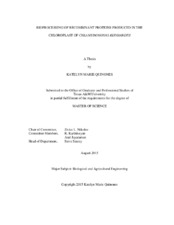| dc.description.abstract | The chloroplast of eukaryotic green algae, Chlamydomonas reinhardtii, is a relatively new and unexplored platform for the production of human therapeutics, vaccines, and human monoclonal antibodies. To accurately determine the viability of algae as a production platform, not only does the titer of correctly folded proteins have to be competitive to existing platforms (insect, yeast, plants, and bacteria) but the ease of downstream processing must also be taken into consideration. Two proteins expressed in the chloroplast of C. reinhardtii were studied, a malaria vaccine candidate (Plasmodium falciparum surface protein 25 (Pfs25)) and a single-chained antibody fragment (αCD22scFv). The first part of this study (Chapter II) had two objectives: (i) increase the accumulation of Pfs25 and (ii) characterize the Pfs25-aggregates. By suspending algal cells in fresh media after 5 days of growth, the accumulation of Pfs25 increased 1.7-fold. The Pfs25-aggregates were separated by size exclusion chromatography (SEC) and found to range in size from 25 kDa to >600 kDa; even in the presence of reducing agents and detergent the higher molecular (MW) aggregates remained intact. Due to the wide variances of Pfs25, evaluating the ease of downstream processing of algae with Pfs25 would prove to be difficult. Previously, our lab used αCD22scFv to compare three pretreatment methods (ammonium sulfate precipitation at pH 8.0, isoelectric precipitation at pH 4.5, and chitosan precipitation at pH 5.0) on residual chlorophyll, DNA, host cell protein, and αCD22scFv yield. However, the pretreatment methods were compared using anti-FLAG-affinity resin (a very specific yet highly expensive resin). Therefore, the second part of this study (Chapter III) used αCD22scFv to (i) test the effect of pretreatment methods on αCD22scFv adsorption to Capto Q and Phenyl Sepharose resins and (ii) develop a purification process resulting in >98% purity. Isoelectric precipitation at pH 4.5 and anion exchange chromatography (AXC) combination was determined to be the best combination for initial recovery and concentration of αCD22scFv. After isoelectric precipitation and AXC, anti-FLAG-affinity resin was the only resin scouted that showed a >98% αCD22scFv purity and 77% yield. | en |


